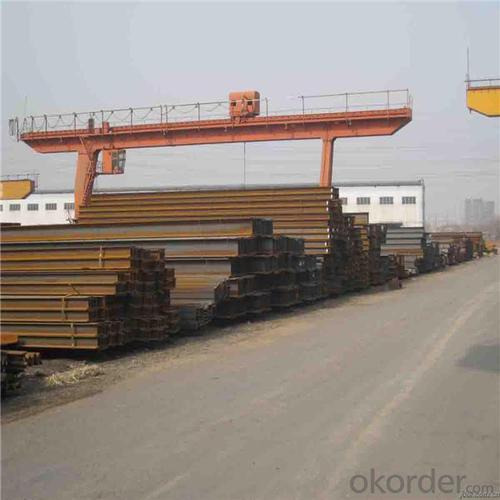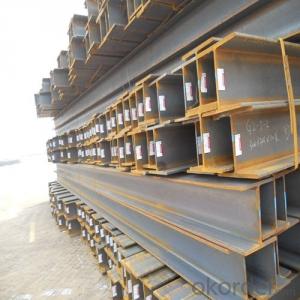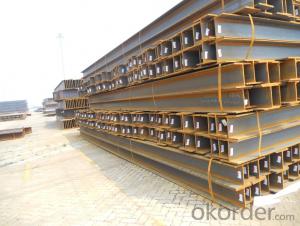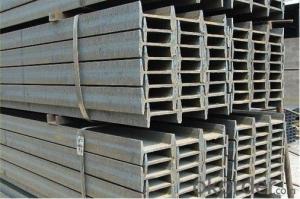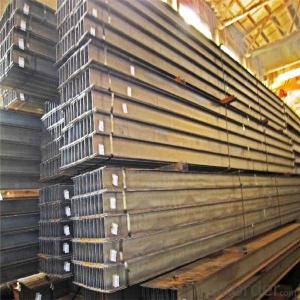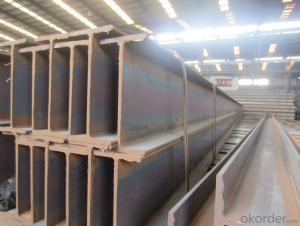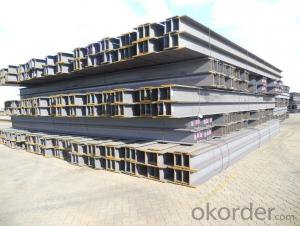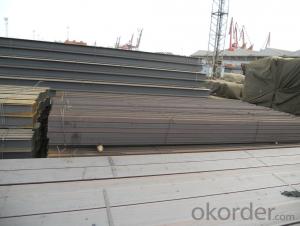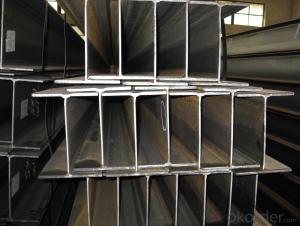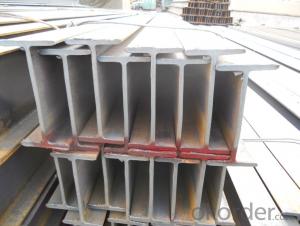Jis Structural H Steel Beams Price per Kg
- Loading Port:
- Dalian
- Payment Terms:
- TT OR LC
- Min Order Qty:
- 135 m.t
- Supply Capability:
- 150000 m.t/month
OKorder Service Pledge
OKorder Financial Service
You Might Also Like
Specification
Quick Detail
Place of Origin: | Jiangsu, China (Mainland) | Grade: | SS400, SS400,ST37-2, A36, S235JR, Q235 | Technique: | Hot Rolled |
Thickness: | 8mm | Application: | construction | Length: | 6m-16m |
Standard: | JIS, ASTM,BS,EN | Flange Width: | 50-34mm | Flange Thickness: | 7-34mm |
Web Width: | 100-900mm | Web Thickness: | 5-30mm | Brand Name: | JZZHD |
Model Number: | 350mm*175mm*7mm*11mm | Name: | Steel h beam structure material/ construction steel | Certificate: | SGS,ISO,CE,TUV |
We can provide qualify goods,competitive price and speedy delivery.
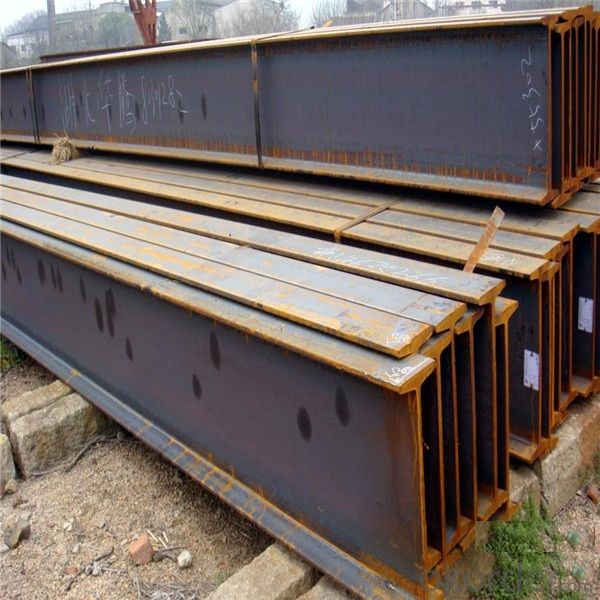
Products Description
H Type Steel Size and Theoretical Weight | |||||
Size | Theoretical Weight | Size | Theoretical Weight | Size | Theoretical Weight |
|
|
|
|
|
|
(mm) | (kg/m) | (mm) | (kg/m) | (mm) | (kg/m) |
100*50*5*7 | 9.3 | 250*125*6*9 | 29 | 446*199*8*12 | 65.1 |
100*100*6*8 | 16.9 | 250*250*9*14 | 71.8 | 450*200*9*14 | 74.9 |
125*60*6*8 | 13.1 | 294*200*8*12 | 55.8 | 482*300*11*15 | 110.8 |
125*125*6.5*9 | 23.6 | 298*149*5.5*8 | 32 | 488*300*11*18 | 124.9 |
148*100*6*9 | 31.1 | 340*250*9*14 | 36.7 | 496*199*9*14 | 77.9 |
150*75*5*7 | 14 | 300*150*6.5*9 | 93 | 500*200*10*16 | 88.1 |
150*150*7*10 | 20.7 | 300*300*10*15 | 78.1 | 582*300*12*17 | 132.8 |
175*90*5*8 | 18 | 346*174*6*9 | 41.2 | 588*300*12*20 | 147 |
175*175*7.5*11 | 40.4 | 350*175*7*11 | 49.4 | 596*199*10*15 | 92.4 |
194*150*6*9 | 29.9 | 350*350*12*19 | 134.9 | 600*200*11*17 | 103.4 |
198*99*4.5*7 | 17.8 | 390*300*10*16 | 104.6 | 700*300*13*24 | 181.8 |
200*100*5.5*8 | 20.9 | 396*199*7*11 | 56.1 | 800*300*14*26 | 206.8 |
200*200*8*12 | 49.9 | 400*200*8*13 | 65.4 | 900*300*16*28 | 240.1 |
244*175*7*11 | 43.6 | 400*400*13*21 | 171.7 |
|
|
248*124*5*8 | 25.1 | 440*300*11*18 | 120.8 |
|
|
Length=6------12meters | |||||
Packaging & Delivery
Packaging Details: | Packed with waterproof paper and steel banding. |
Delivery Detail: | 15-25 |
FAQ
1. How can I get some samples?
We are honored to offer you samples. New clients are expected to pay for the courier cost. The samples are free for you.
2 Do you have any certificates?
Our products passed inspection of SGS, FDA, and CE Quality is priority! Every worker keeps the QC from the very beginning to the very end, Quality control department especially responsible for quality checking in each process.
3 Can your factory print or emboss my logo on the goods?
Yes, we can print or emboss the logo on the goods or their packing box.
4 What information should I let you know if I want to get a quotation?
1) The specification of products (length x width x thickness);
2) The temper and alloy.
3) The final product you will use to be made
4 It will be better if you can show us the pictures or design sketch. Samples will be best for clarifying. If not, we will recommend relevant products with details for reference.We usually produce goods based on customers
Samples or based on customers’ picture, logo, sizes etc.
- Q: Can steel H-beams be used for railway bridges or overpasses?
- Certainly! Steel H-beams are a viable option for railway bridges or overpasses. They are widely used in construction owing to their remarkable strength-to-weight ratio, rendering them suitable for bearing heavy loads. The materials required for railway bridges and overpasses must be robust and enduring to support the weight of trains, and steel H-beams are well-suited for this purpose. They provide structural stability, possess the ability to endure significant loads and forces, and can span considerable distances. Moreover, steel H-beams possess resistance against corrosion, a crucial attribute for structures exposed to the elements. All in all, due to their strength, durability, and versatility, steel H-beams are a favored choice for railway bridges and overpasses.
- Q: How do steel H-beams contribute to the load-bearing capacity of a structure?
- The load-bearing capacity of a structure is enhanced by steel H-beams due to their unique design and material properties. The H-shaped cross-section of these beams offers a larger surface area compared to other structural shapes, resulting in increased strength and load-carrying capacity. To resist bending and shear forces, the flanges, which are the top and bottom horizontal sections of the H-beam, are specifically designed. They serve as a platform to evenly distribute the load along the length of the beam, ensuring efficient load transfer. The web, or vertical section, connects the flanges and adds rigidity and stability to the beam. Steel, being a robust and durable material, further improves the load-bearing capacity of H-beams. It possesses high tensile and compressive strength, enabling the beams to withstand heavy loads and resist deformation. Additionally, steel exhibits excellent resistance to fire, corrosion, and other environmental factors, guaranteeing the long-term structural integrity of the building. The load-bearing capacity of H-beams is also influenced by their versatility. They can be manufactured in various sizes and lengths, making them suitable for a wide range of applications and structural needs. Furthermore, H-beams can be easily connected through welding or bolted connections, allowing the construction of intricate and sturdy frameworks. In conclusion, steel H-beams play a crucial role in enhancing the load-bearing capacity of a structure by providing a robust and efficient structural component. Their unique design, combined with the strength and durability of steel, enables them to support heavy loads and ensure the overall stability and safety of the building.
- Q: Are steel H-beams resistant to water or moisture damage?
- Steel H-beams are highly resistant to water and moisture damage. Unlike wood or other organic materials, steel does not absorb water or moisture. This characteristic prevents steel H-beams from rotting, warping, or deteriorating when exposed to water or moisture. Moreover, steel is also resistant to the growth of mold and mildew, making it even more durable in wet or humid environments. Some steel H-beams are coated with galvanized protection to further prevent corrosion caused by moisture exposure. However, it is important to note that while the steel H-beams themselves are resistant to water or moisture damage, the connections or joints between the beams may corrode if precautions are not taken. Therefore, regular maintenance and inspections are necessary to ensure the long-term integrity and performance of steel H-beams in wet or humid conditions.
- Q: Are steel H-beams resistant to UV radiation?
- UV radiation can pose a challenge to the resilience of Steel H-beams. Steel as a material can be prone to corrosion and decay if exposed to UV radiation for a prolonged duration. Nevertheless, there exist several techniques to safeguard Steel H-beams against UV radiation. These methods involve applying a protective coating or utilizing weather-resistant materials in the manufacturing process. By implementing these measures, the endurance and lifespan of Steel H-beams can be significantly improved even when faced with UV radiation. To determine the most appropriate approach for protecting Steel H-beams from UV radiation, it is crucial to consider the specific application and environmental conditions.
- Q: What are the different types of steel H-beam profiles available?
- There exists a variety of steel H-beam profiles, each possessing their own distinct characteristics and applications. Here are several commonly encountered types: 1. W-beams, also known as wide flange beams, are characterized by their broader flange and are frequently employed in construction projects necessitating substantial support. These beams are renowned for their stability and resistance against bending. 2. S-beams, or American standard beams, possess a narrower flange when compared to W-beams and are often utilized in lighter structural endeavors. They offer a more cost-effective and manageable alternative to W-beams. 3. J-beams, also referred to as junior beams, feature a lighter weight and smaller profile in comparison to W-beams and standard beams. They are commonly employed in residential construction or smaller-scale projects. 4. HEB, HEM, and IPE beams, adhering to European standards, are extensively deployed in construction undertakings throughout Europe. HEB beams possess a wide flange, while HEM beams boast a wide flange and higher moment of inertia. IPE beams, characterized by a narrower flange, are often found in residential buildings. 5. JIS beams, conforming to Japanese industrial standards, are widely employed in construction ventures within Japan and other Asian nations. They are available in various sizes and profiles, including H, HP, and B series. 6. UB beams, also known as universal beams, feature a wide flange and are frequently utilized in construction projects necessitating versatility and strength. They are commonly found in bridges, buildings, and other structural applications. 7. Tapered beams possess a flange that gradually narrows, enabling better weight distribution and load-bearing capacity. They are frequently employed in roof trusses, bridges, and other scenarios where weight reduction is crucial. These aforementioned examples represent merely a selection of the diverse steel H-beam profiles available. The choice of profile hinges upon specific project requirements, including load-bearing capacity, span, and cost-effectiveness. Consulting a structural engineer or steel supplier can assist in determining the most suitable profile for a given application.
- Q: What are the different sizes of steel H-beams available?
- The sizes of steel H-beams available vary depending on the manufacturer and supplier. However, some common sizes include H-beams with depths ranging from 4 inches to over 40 inches, and flange widths ranging from 4 inches to over 20 inches. These sizes are often designated using standard measurements such as inches or millimeters.
- Q: Can steel H-beams be cut or modified on-site?
- Steel H-beams have the capability to be cut or modified directly at the construction site. Construction projects frequently employ H-beams, which can be tailored to meet exact measurements and specifications. On-site modifications of H-beams might involve cutting the beams to the desired length, drilling holes for fasteners, or welding extra pieces to establish connections or supports. Nevertheless, it is crucial to emphasize the necessity of employing appropriate safety measures and equipment when conducting on-site cutting or modification of steel beams.
- Q: How do steel H-beams contribute to the overall aesthetics of a building?
- Steel H-beams contribute to the overall aesthetics of a building by providing a sleek and modern appearance. Their clean lines and structural integrity create a visually appealing framework that adds a sense of strength and stability to the structure. Additionally, the ability to span long distances without the need for additional support columns allows for open and spacious interior designs, enhancing the overall aesthetic appeal of the building.
- Q: Can steel H-beams be used for office buildings or commercial complexes?
- Certainly, office buildings or commercial complexes can absolutely utilize steel H-beams. The construction industry frequently relies on steel H-beams due to their robustness, longevity, and adaptability. These beams furnish essential support and solidity to the building, rendering them suitable for extensive undertakings like office buildings or commercial complexes. Their exceptional load-bearing capacity makes them an ideal choice for spanning vast distances and sustaining heavy loads, which are typical prerequisites in such edifices. Furthermore, steel H-beams possess the added benefit of being fire-resistant, a vital aspect for the safety of occupants in commercial establishments. All in all, the inclusion of steel H-beams within office buildings or commercial complexes ensures a sturdy and dependable structural framework that is capable of withstanding the demands associated with these specific types of structures.
- Q: How do steel H-beams perform in coastal environments?
- Steel H-beams perform well in coastal environments as they are highly resistant to corrosion. The steel used in H-beams is typically galvanized or coated with protective materials to prevent rusting and deterioration caused by exposure to saltwater, humidity, and other corrosive elements present in the coastal environment. This coating ensures the longevity and structural integrity of the H-beams, making them suitable for various applications like bridges, piers, and buildings in coastal areas. Additionally, the robust design of H-beams provides excellent load-bearing capacity, making them ideal for withstanding the strong winds and heavy loads often experienced in coastal regions. Overall, steel H-beams are a reliable and durable choice for construction projects in coastal environments.
Send your message to us
Jis Structural H Steel Beams Price per Kg
- Loading Port:
- Dalian
- Payment Terms:
- TT OR LC
- Min Order Qty:
- 135 m.t
- Supply Capability:
- 150000 m.t/month
OKorder Service Pledge
OKorder Financial Service
Similar products
Hot products
Hot Searches
Related keywords



